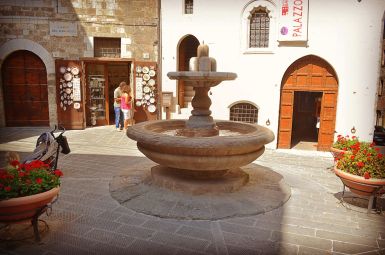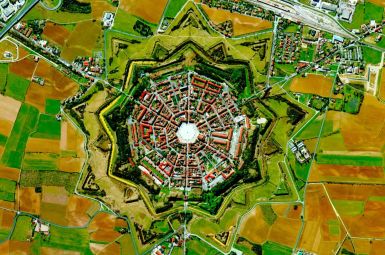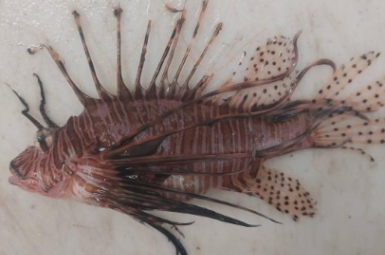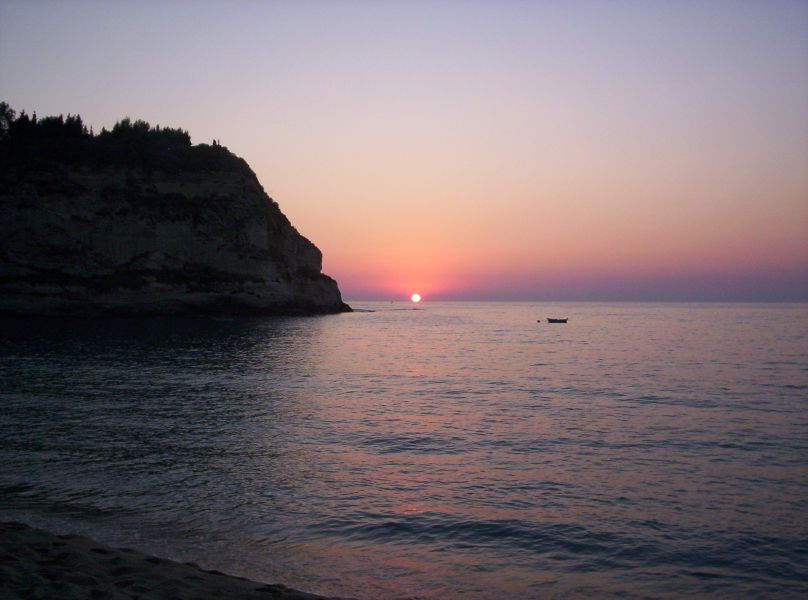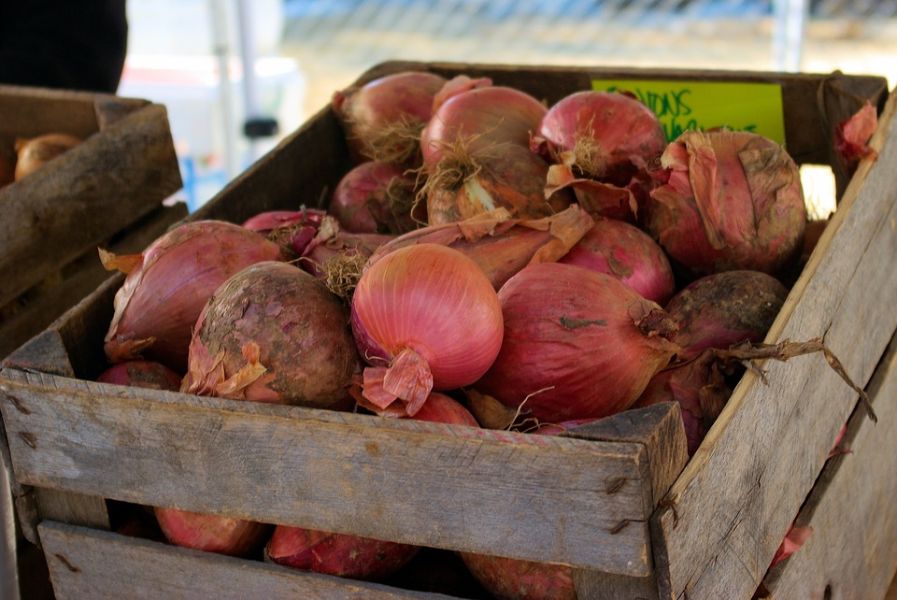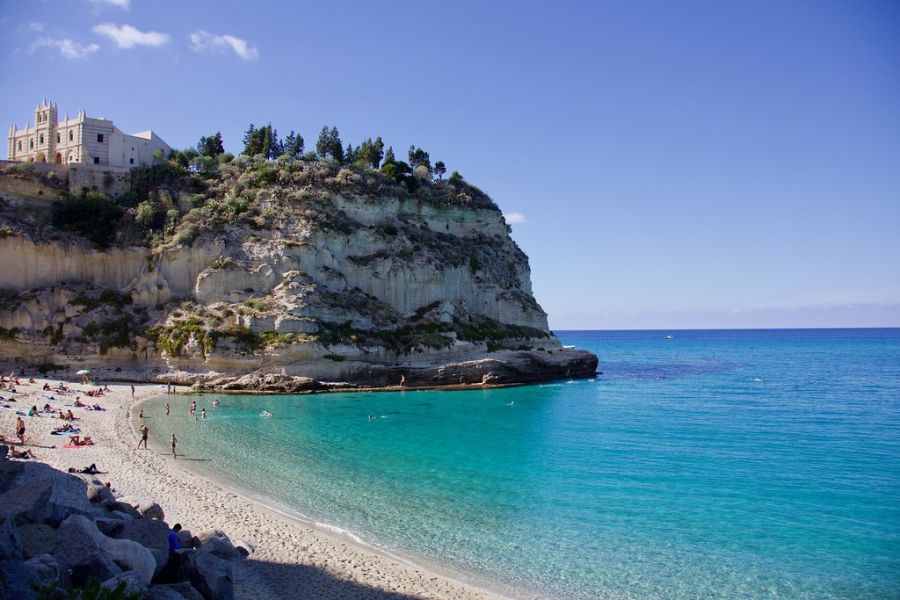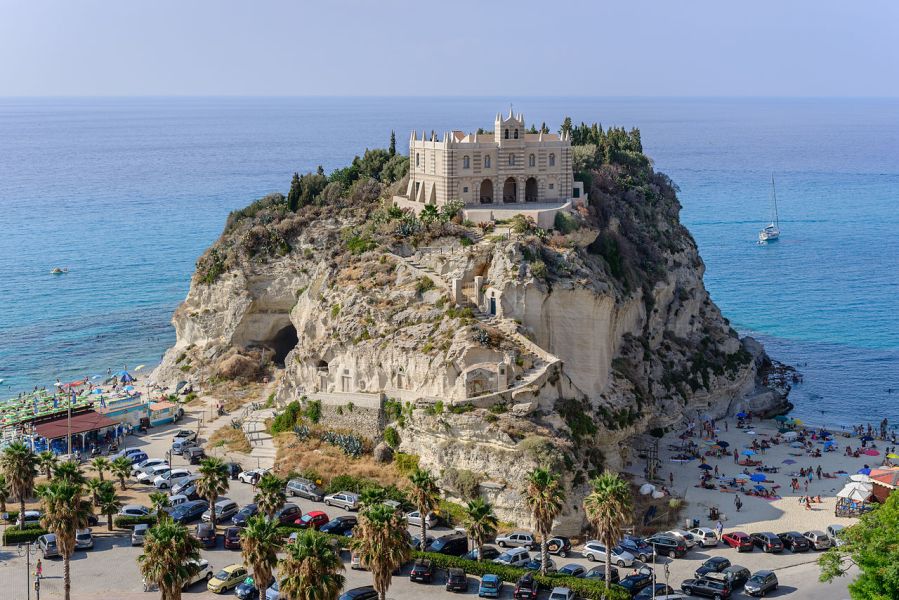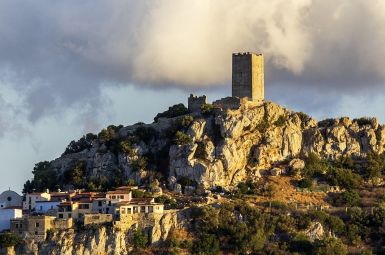
Il Borgo di Tropea
Tropea: La Perla del Tirreno e Regina della Costa degli Dei
Tropea non è solo una destinazione; è un’icona, una visione di bellezza senza tempo che si staglia imponente sulla Costa degli Dei calabrese. Questo borgo storico, costruito su un’alta rupe di tufo a picco sul Mar Tirreno, offre un mix ineguagliabile di storia millenaria, architettura mozzafiato e una natura marina di eccezionale limpidezza.Il Paesaggio: Tra Rupes e Acque Cristalline
Il fascino inconfondibile di Tropea risiede nel suo scenario drammatico e perfetto:- La Rupe e il Centro Storico: Il nucleo antico della città si erge fieramente sulla rupe, creando un contrasto spettacolare tra le case nobiliari e i palazzi signorili a strapiombo e il blu profondo del mare sottostante. Le terrazze panoramiche offrono scorci indimenticabili, soprattutto al tramonto, quando il sole scompare dietro lo Stromboli, visibile all’orizzonte.
- Spiagge d’Oro e Acqua Turchese: Ai piedi della rupe si estendono le spiagge di sabbia chiara e le calette nascoste, bagnate da un mare che le ha valso più volte il titolo di Bandiera Blu. La trasparenza delle acque è leggendaria, ideale per nuoto, snorkeling e immersioni.
Il Simbolo: Il Santuario di Santa Maria dell’Isola
L’immagine più celebre e iconica di Tropea è il Santuario di Santa Maria dell’Isola .- Una Chiesa sulla Roccia: Costruito su un piccolo scoglio di arenaria che un tempo era completamente isolato (da qui il nome), il Santuario è oggi collegato alla terraferma da una scalinata. Il monastero benedettino risale al periodo medievale e, dopo essere stato ricostruito a seguito di diversi terremoti, domina maestosamente il paesaggio. La sua posizione lo rende un luogo di profonda spiritualità e un punto panoramico impareggiabile.
L’Identità Gastronomica: La Cipolla Rossa
L’identità di Tropea non è completa senza citare il suo prodotto della terra più famoso e apprezzato a livello internazionale: la Cipolla Rossa di Tropea Calabria I.G.P.- Dolcezza e Versatilità: Celebre per la sua inconfondibile dolcezza e la sua bassa acidità, questa cipolla non è solo un ortaggio, ma un vero e proprio ambasciatore del gusto calabrese.
- Dall’Orto alla Tavola: La si trova in ogni preparazione locale, dalle insalate fresche ai piatti di pesce, dalle confetture fino a essere gustata semplicemente cruda o in deliziose fritture. È il sapore della terra che bilancia perfettamente i frutti del mare Tirreno.
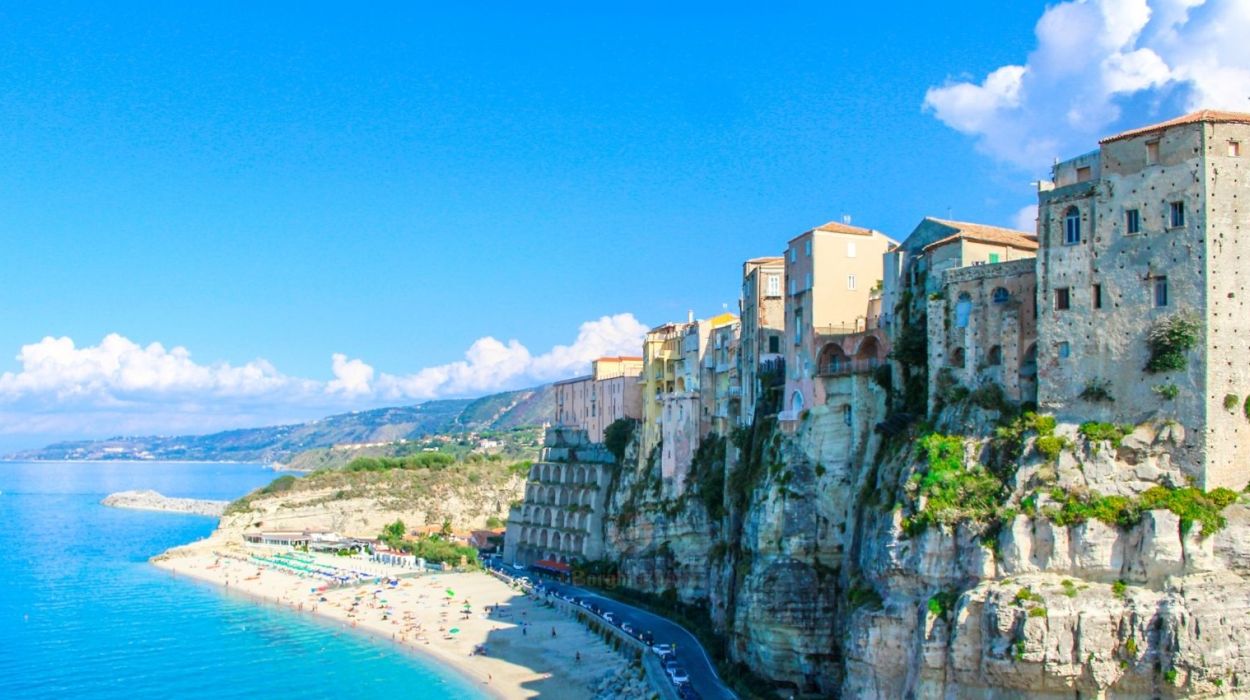
Il Borgo d’Italia
tutto da scoprire ed esplorare
Monumenti
La storia
La presenza di un insediamento umano nella zona di Tropea è attestata fin dall’età del bronzo, solo successivamente i confini tra la storia e la mitologia diventano labili e a tratti indistinguibili. Per questo è difficile ancora oggi ricondurre la fondazione della città ad una data e ad un popolo.
Si narra che in principio ci sia stato Portercole, una cittadina sorta per volere di Ercole che passò da qui durante i suoi viaggi alla ricerca del Vello d’Oro, oppure si pensa che giunse di proposito per liberare la zona dai giganti e che in seguito volle edificare una città in onore di Giunone, che lo aveva nutrito quando era ancora in fasce. Un’altra ipotesi riconduce la fondazione di questo borgo calabro a Scipione l’Africano, che giunse in Italia dopo aver sconfitto Cartagine e ordinò la fondazione di una città dal nome Trophea, per onorare gli dei che lo avevano sostenuto nell’impresa cartaginese.
Con certezza possiamo solo sapere che la presenza di diversi toponimi nelle fonti scritte giunte fino a noi non ha aiutato l’analisi storica.
La posizione geografica di Tropea, affacciata sul mare, è stata nei secoli croce e delizia del borgo. Sebbene abbia goduto dei vantaggi di trovarsi sulle principali rotte commerciali, è stata anche maggiormente esposta alle conquiste delle genti straniere. Infatti dopo la caduta dell’Impero Romano d’Occidente, è stata contesa tra Bisanzio e i mercenari saraceni, che per due volte hanno stabilito a Tropea il proprio emirato arabo.
Nel 1060 giunsero in meridione i Normanni: Roberto il Guiscardo ricevette dal papa i territori della Puglia e della Calabria e per ringraziarlo avviò un processo di conversione in tutti i borghi, costruendo abazie, conventi e chiese. Da questo momento in poi Tropea ha attraversato un periodo di crescita che l’ha portata fino alle porte del ‘Settecento.
in questi secoli Tropea è cresciuta sia dal punto di vista demografico che cittadino. Il ‘Cinquecento è stato il secolo in cui è stata governata dai Nobili e dagli Onorati; durante il Rinascimento nel borgo è stata fondata l’Accademia degli Affaticati, a cui accedevano personaggi colti e dalle rinomate doti morali. Inoltre, sempre in questo periodo, sono state avviate le costruzioni di edifici pubblici e dimore private.
Durante il secolo dei lumi Tropea è stata intaccata da alcune rivolte popolari e da un violento terremoto che ha danneggiato gran parte dell’abitato. Il periodo post unitario poi ha accelerato il declino di Tropea, a causa della scelta di molti giovani di emigrare in America e nel Nord Europa ma anche per via della demolizione di molti monumenti, come il castello e la chiesa di San Giorgio, che era stata costruita in epoca romana come tempio dedicato a Marte.
Oggi, anche se il borgo ha risentito molto della distruzione del suo centro storico, Tropea resta una città che brilla sotto la luce di un fascino particolare, favorita dalla rupe su cui sorge e dalle acque limpide che la lambiscono.
La chiesa di Santa Maria dell’Isola
La chiesa della Madonna dell’Isola è un luogo dal suggestivo potere spirituale, che vale la pena visitare almeno una volta nella vita, sia che siate credenti sia che non lo siate.
Con il terremoto del 1783 un’onda anomala ha arenato sulla spiaggia un piccolo isolotto che precedentemente si trovava a largo. Sopra questo piccolo promontorio spicca nel verde della macchia mediterranea una chiesa dalle tonalità candide. Sulla sua costruzione si sa poco: probabilmente in principio l’isola era abitata da un gruppo di monaci eremiti e successivamente, con l’arrivo dei Normanni, la chiesa è stata donata all’abazia di Montecassino, di cui ancora oggi è pertinenza.
L’isola con la sua chiesa è il simbolo indiscusso di Tropea e della Calabria e, come spesso accade, è legata ad un’antica leggenda. Si racconta che in tempi antichissimi giunse a Tropea una nave dall’oriente che non riuscì a riprendere il mare fin quando non donò alla città la statua della Madonna che trasportava. Il sindaco e il vescovo trasportarono la Madonna in una nicchia, ma la statua era troppo grande e così decisero di chiamare un falegname che le segasse le gambe. Mentre l’uomo si accingeva a compiere l’opera richiesta, improvvisamente rimase paralizzato e il sindaco e il vescovo morirono di colpo. La statua venne trasportata in un altro luogo e nei giorni seguenti ha compiuto diversi miracoli per il popolo. Oggi si sono perse le tracce di questa Madonna, ma fino a qualche decennio fa era consuetudine giungere in pellegrinaggio nella grotta dove si trovava per chiedere una grazia.
A causa dei terremoti del 1783 e del 1905 la chiesa ha perso gran parte del suo aspetto originale. Oggi una lunga scalinata conduce allo spiazzale da cui si può ammirare la bellezza di Tropea. All’interno dell’edificio si può ammirare un organo a canne, che rientra tra i pezzi pregiati custoditi all’interno di questo luogo di culto.
Duomo di Tropea
Il duomo di Tropea si trova nel cuore del centro storico, precisamente si affaccia sul largo a cui da’ il nome.
Questo luogo di culto è stato edificato durante il periodo della dominazione normanna, a seguito del progetto di latinizzazione voluto da Roberto Il Guiscardo.
La chiesa è stata costruita su un cimitero bizantino ed è stata realizzata con conci di tufo color ocra e pietra lavica, nel ‘Seicento è stata modificata ed è stata approntata ad uno stile barocco, in linea con i dettami della Controriforma cattolica. A parte questo, nonostante i numerosi danni subiti dai terremoti, durante i restauri si è sempre cercato di ristabilire l’aspetto originale. La facciata è contraddistinta da un portale con arco in tufo e dalla ripetizione di archi, sempre in tufo, sul lato sinistro del prospetto, dove si trova anche un’effige della Madonna di Romania, patrona di Tropea.
All’interno del duomo sono custodite diverse opere di grande prestigio, prima fra tutti la rappresentazione originaria della Madonna di Romania, che si trova sull’altare maggiore. Quest’opera è stata realizzata probabilmente nel 1230, da un allievo di Giotto.
Di particolare importanza sono anche un crocefisso nero, probabilmente realizzato nel ‘Seicento e giunto dalla Francia, una statua della Madonna del Popolo, il pulpito del ‘Settecento e una statua della Madonna della Libertà, realizzata nel XVII secolo in Marmo di Carrara.
Curiosità
La cipolla di Tropea
La cipolla rossa di Tropea non è una cipolla qualsiasi: è La Cipolla! La sua dolcezza e la sua croccantezza hanno conquistato tutto il mondo e ogni anno la coltivazione certificata IGP di questo ortaggio cresce sempre di più.
La cipolla rossa venne introdotta in Calabria dai Fenici e dai Greci e storicamente si coltivava nella zona di Capo Vaticano, nel comune di Ricardi. Dai campi veniva poi trasportata su carretti trainati da buoi fino alla stazione di Tropea, da cui partiva per ogni direzione del continente. Viene coltivata su territori vulcanici, profondi e ricchi di potassio ed è una vera e propria risorsa per l’intera Calabria. Il Consorzio di Tutela della Cipolla Rossa di Tropea vanta infatti un indotto di venticinque milioni di euro, con un’occupazione di seimila persone e mille ettari coltivati e i numeri sono destinati a crescere.
La Cipolla Rossa di Tropea è un souvenir molto richiesto dai visitatori che giungono in Calabria e questa terra ha saputo riconoscere il suo inestimabile valore. Questa particolare cipolla è infatti un elisir di salute, utile contro la calcolosi renale, per la purificazione del sangue, come antiossidante, ma anche per la cura del raffreddore e ha molte molte altre qualità. Le proprietà benefiche di questa cipolla sono state studiate e messe a regime da alcuni ricercatori dell’Università della Calabria e della Magna Graecia che hanno vinto il premio Clinic Center Life Science con la start up Ry Goldzip e l’invenzione di una crema che sfruttando i principi attivi contenuti nella cipolla di Tropea permette un acceleramento dei tempi di cicatrizzazione delle ulcere diabetiche, senza usare antinfiammatori e antibiotici.
La cipolla di Tropea è un ingrediente irrinunciabile nella cucina italiana, regina incontrastata dei soffritti e delle insalate estive, noi ve la consigliamo come confettura, abbinata ad un secondo di carne ma anche ad un formaggio come il pecorino e il caciocavallo.
La Cipolla Rossa di Tropea è anche e soprattutto il simbolo del riscatto di una terra che vuole svincolarsi dalla criminalità e dalla sua azione deleteria, oggi è l’emblema di un territorio che sta rinascendo e i dati sembrano spingere questo carrozzone rosso: il 2017 è stato l’anno della cipolla di Tropea e le previsioni per il 2018 sembrano confermare quest’ascesa.
Personaggi
Santa Domenica (di Tropea)
Santa Domenica nacque a Tropea da una nobile famiglia greca, durante l’Impero romano di Diocleziano Augusto.
I suoi genitori, Doroteo e Arsenia, erano ferventi cristiani e desideravano ardentemente avere un figlio. Dopo molto tempo finalmente i due riuscirono a mettere al mondo una bambina, che chiamarono appunto Domenica, perché nata nel giorno del Signore.
Domenica era una bambina timida e tranquilla, ubbidiente nei confronti dei genitori e fedele a Dio. Tanto che quando giunse in età da marito, anziché sposarsi come facevano le sue coetanee, decise di consacrare la sua purezza al Signore.
Per Domenica e la sua famiglia la fede in Cristo cresceva di giorno in giorno e riuscirono a coinvolgere sempre più amici e vicini, tanto da arrivare a trasformare la propria casa in un tempio.
Inizialmente l’impero di Diocleziano fu contraddistinto da una tregua nei confronti dei cristiani, ma dopo appena due anni dal suo insediamento la situazione cambiò e iniziò un’efferata persecuzione nei confronti dei fedeli di Cristo.
Domenica e la sua famiglia vengono denunciati come nemici degli dei. Probabilmente era una famiglia che godeva di una condizione socialmente agiata, perché il loro caso arrivò all’attenzione dell’imperatore che chiese di vederli personalmente.
I tre vennero condotti a Nola in Campania, dove si trovava Diocleziano. Portati davanti al giudizio di un giudice quest’ultimo chiese a Domenica di rinunciare alla sua fede in Cristo, ma la fanciulla rispose che mai l’avrebbe fatto. L’imperatore ordinò che la famiglia venisse frustata in pubblica piazza e nei luoghi più frequentati della città.
Diocleziano decise poi di rinchiudere i genitori di Domenica in prigione e di portati in Armenia, dove il governatore di Mitilene li condannò al taglio della testa.
L’imperatore fu costretto a spostarsi in oriente e lasciò le questioni d’occidente a Massimiano. Quest’ultimo trovandosi davanti a Domenica venne soggiogato dal suo innegabile fascino e provò invano a sedurla in ogni modo.
Frustrato e afflitto Massimiano fece portare Domenica in prigione e dopo qualche giorno la liberò e la consegnò ad una meretrice, che aveva il compito di dissuaderla dal suo voto di castità. Anche questo tentativo non ebbe esito positivo. L’imperatore allora ordinò che venisse gettata a terra e calpestata ma nonostante questo Domenica riuscì a rialzarsi.
Venne mandata in Campania dove venne sottoposta a nuovi terribili supplizi che riuscì tutti a vincere. Domenica venne quindi condannata al taglio della testa, che affrontò con coraggio, chiedendo prima di rivolgere un’ultima preghiera a Dio.
Ricette Tipiche
Frittata di Cipolla Rossa di Tropea
La regina incontrastata della cucina di questa terra non può che essere la cipolla, la si può mangiare cruda o cotta ma resta sempre una delizia. Uno dei piatti tipici di Tropea è proprio la frittata di cipolle rosse.
Ingredienti:
- 4 uova;
- 2 Cipolle Rosse di Tropea, originali;
- Pecorino grattugiato, q.b;
- Olio extravergine di oliva;
- Un ciuffo di prezzemolo;
- Sale;
- Pepe nero;
Preparazione:
Togliere gli strati esterni delle cipolle e tritare finemente la restante parte. Scaldare un filo d’olio in padella, aggiungere le cipolle, coprirle con un coperchio e lasciarle stufare fino ad ottenere quasi una crema. Aggiustare di sale
In una ciotola mescolare le uova con il pecorino, aggiungere pepe, ed infine le cipolle stufate.
In una pentola antiaderente far riscaldare un po’ d’olio e poi aggiungere il composto, far cuocere a fuoco medio prima dieci minuti da un lato, poi girarlo e farlo cuocere cinque minuti dall’altro.
Quando la frittata sarà pronta potrete deciderla se servirla calda oppure leggermente tiepida, sarà comunque un’eccezionale bontà.
